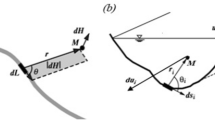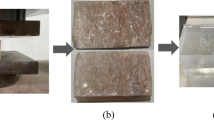Abstract
Precise and efficient numerical simulation of transport processes in subsurface systems is a prerequisite for many site investigation or remediation studies. Random walk particle tracking (RWPT) methods have been introduced in the past to overcome numerical difficulties when simulating propagation processes in porous media such as advection-dominated mass transport. Crucial for the precision of RWPT methods is the accuracy of the numerically calculated ground water velocity field. In this paper, a global node-based method for velocity calculation is used, which was originally proposed by Yeh (Water Resour Res 7:1216–1225, 1981). This method is improved in three ways: (1) extension to unstructured grids, (2) significant enhancement of computational efficiency, and (3) extension to saturated (groundwater) as well as unsaturated systems (soil water). The novel RWPT method is tested with numerical benchmark examples from the literature and used in two field scale applications of contaminant transport in saturated and unsaturated ground water. To evaluate advective transport of the model, the accuracy of the velocity field is demonstrated by comparing several published results of particle pathlines or streamlines. Given the chosen test problem, the global node-based velocity estimation is found to be as accurate as the CK method (Cordes and Kinzelbach in Water Resour Res 28(11):2903–2911, 1992) but less accurate than the mixed or mixed-hybrid finite element methods for flow in highly heterogeneous media. To evaluate advective–diffusive transport, a transport problem studied by Hassan and Mohamed (J Hydrol 275(3–4):242–260, 2003) is investigated here and evaluated using different numbers of particles. The results indicate that the number of particles required for the given problem is decreased using the proposed method by about two orders of magnitude without losing accuracy of the concentration contours as compared to the published numbers.












Similar content being viewed by others
References
Ackerer P, Mose R, Siegel P, Chavent G (1996) Application of the mixed hybrid finite element approximation in a groundwater flow model: luxury or necessity? Reply. Water Resour Res 32(6):1911–1913
Bear J (1972) Dynamics of fluids in porous media. American Elsevier, New York, 761 p
Bear J (1979) Hydraulics of groundwater. McGraw-Hill, New York
Bensabat J, Zhou QL, Bear J (2000) An adaptive pathline-based particle tracking algorithm for the Eulerian-Lagrangian method. Adv Water Resour 23(4):383–397
Beyer C, Konrad W, Park CH, Bauer S, Rügner H, Liedl R, Grathwohl P (2007) Modellbasierte Sickerwasserprognose für die Verwertung von Recycling-Baustoffen in technischen Bauwerken. (Model based prognosis of contaminant leaching for reuse of demolition waste in construction projects). Grundwasser 12(2):94–107
Brezzi F, Fortin M (1991) Mixed and hybrid finite elements methods. Springer, New York
Chavent G, Roberts JE (1991) A unified physcial presentation of mixed, mixed-hybrid finite elements and standard finite difference approximations for the determination of velocities in waterflow problems. Adv Water Resour 14(6):329–348
Cheng HP, Cheng JR, Yeh GT (1996) A particle tracking technique for the Lagrangian-Eulerian finite element method in multi-dimensions. Int J Numer Methods Eng 39(7):1115–1136
Cirpka OA, Frind EO, Helmig R (1999) Streamline-oriented grid generation for transport modelling in two-dimensional domains including wells. Adv Water Resour 22(7):697–710
Cordes C, Kinzelbach W (1992) Continuous groundwater velocity fields and path lines in linear, bilinear, and trilinear finite elements. Water Resour Res 28(11):2903–2911
Cordes C, Kinzelbach W (1996) Application of the mixed hybrid finite element approximation in a groundwater flow model: luxury or necessity? Comment. Water Resour Res 32(6):1905–1909
Cortis A, Berkowitz B (2005) Anomalous transport in "classical" soil and sand columns. Soil Sci Soc Am J 69(1):285
Delay F, Ackerer P, Danquigny C (2005) Simulating solute transport in porous or fractured formations using random walk particle tracking: a review. Vadose Zone J 4(2):360–379
Durlofsky LJ (1994) Accuracy of mixed and control-volume finite-element approximations to Darcy velocity and related quantities. Water Resour Res 30(4):965–973
Finkel M, Liedl R, Teutsch G (1999) Modelling surfactant-enhanced remediation of polycyclic aromatic hydrocarbons. Environ Model Softw 14(2–3):203–211
Freeze RA, Cherry JA (1979) Groundwater. Prentice–Hall, Englewood Cliffs, 604 p
Grathwohl P (1998) Diffusion in natural porous media: contaminant transport, sorption/desorption and dissolution kinetics, 224 S. Kluwer, Boston
Haegland H (2003) Streamline tracing in irregular grids. Cand. Scient. Thesis, University of Bergen, Norway
Haegland H, Dahle HK, Eigestad GT, Lie K-A, Aavatsmark I (2007) Improved streamlines and time-of-flight for streamline simulation on irregular grids. Adv Water Resour 30(4):1027–1045
Hassan AE, Mohamed MM (2003) On using particle tracking methods to simulate transport in single-continuum and dual continua porous media. J Hydrol 275(3–4):242–260
Hoteit H, Mose R, Younes A, Lehmann F, Ackerer P (2002) Three-dimensional modeling of mass transfer in porous media using the mixed hybrid finite elements and the random-walk methods. Math Geol 34(4):435–456
Jang WY, Aral MM (2007) Density-driven transport of volatile organic compounds and its impact on contaminated groundwater plume evolution. Transp Porous Media 67(3):353–374
Jury WA, Gardner WR, Gardner WH (1991) Soil physics. Wiley, New York, 328 p
Kinzelbach W (1986) Groundwater modelling: an introduction with sample programs in BASIC Wolfgang Kinzelbach. Elsevier, Amsterdam
Kolditz O, Wang W, Hesser J, Shao H, Du Y, Park C-H (2007a) Geosys/rockflow benchmarking. Center for Applied Geoscience, University of Tuebingen, GeoSys (Preprint)
Kolditz O, Du Y, Bürger C, Delfs J, Kuntz D, Beinhorn M, Hess M, Wang W, van der Grift B, te Stroet C (2007b) Development of a regional hydrologic soil model and application to the Beerze-Reusel drainage basin. Environ Pollut (in press)
LaBolle EM, Fogg GE, Tompson AFB (1996) Random-walk simulation of transport in heterogeneous porous media: local mass-conservation problem and implementation methods. Water Resour Res 32(3):583–593
Matringe SF, Juanes R, Tchelepi HA (2006) Robust streamline tracing for the simulation of porous media flow on general triangular and quadrilateral grids. J Comput Phys 219(2):992–1012
Mayer KU, Benner SG, Blowes DW, Frind EO (1999) The reactive transport model MIN3P: application to acid mine drainage generation and treatment—Nickel Rim Mine site, Sudbury, Ontario, vol 1. In: Conference on mining and the environment, pp 145–154
Mose R, Siegel P, Ackerer P, Chavent G (1994) Application of the mixed hybrid finite-element approximation in a groundwater-flow model—luxury or necessity. Water Resour Res 30(11):3001–3012
Ogata A, Banks RB (1961) A solution of the differential equation of longitudinal dispersion in porous media; fluid movement in earth materials. US Govt Print Off, Washington
Oliveira A, Baptista AM (1998) On the role of tracking on Eulerian-Lagrangian solutions of the transport equation. Adv Water Resour 21(7):539–554
Park C-H, Aral MM (2007) Sensitivity of the solution of the Elder problem to density, velocity and numerical perturbations. J Contam Hydrol 92:33–49
Park C-H, Beyer C, Bauer S, Kolditz O (2007) Benchmark test for random walk particle tracking methods. Center for Applied Geoscience, University of Tuebingen, GeoSys (Preprint)
Pollock DW (1988) Semianalytical computation of path lines for finite-difference models. Ground Water 26(6):743–750
Prevost M (2000) The streamline method for unstuctured grids. MS, Standford University, USA
Prevost M, Edwards MG, Blunt MJ (2002) Streamline tracing on curvilinear structured and unstructured grids. SPE J 7(2):139–148
Salamon P, Fernandez-Garcia D, Gomez-Hernandez JJ (2006) A review and numerical assessment of the random walk particle tracking method. J Contam Hydrol 87(3–4):277–305
Tompson AFB, Gelhar LW (1990) Numerical-simulation of solute transport in 3-dimensional, ramdomly heterogeneous porous-media. Water Resour Res 26(10):2541-2562
Šimůnek J, van Genuchten MT, Šejna M (2005) The Hydrus-1d software package for simulating the one-dimensional movement of water, heat, and multiple solutes in variably-saturated media, version 3.0. Technical Report. Department of Environmental Science, University of California Riverside
Warrick AW, Biggar JW, Nielsen DR (1971) Simultaneous solute and water transfer for an unsaturated soil. Water Resour Res 7:1216–1225
Yeh GT (1981) On the computation of darcian velocity and mass balance in the finite-element modeling of groundwater-flow. Water Resour Res 17(5):1529–1534
Author information
Authors and Affiliations
Corresponding author
Rights and permissions
About this article
Cite this article
Park, CH., Beyer, C., Bauer, S. et al. Using global node-based velocity in random walk particle tracking in variably saturated porous media: application to contaminant leaching from road constructions. Environ Geol 55, 1755–1766 (2008). https://doi.org/10.1007/s00254-007-1126-7
Received:
Accepted:
Published:
Issue Date:
DOI: https://doi.org/10.1007/s00254-007-1126-7




